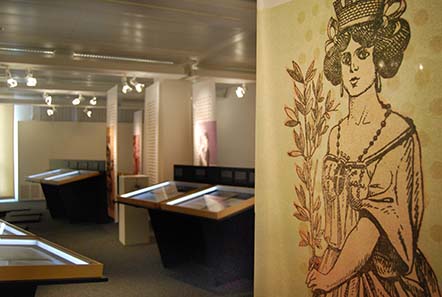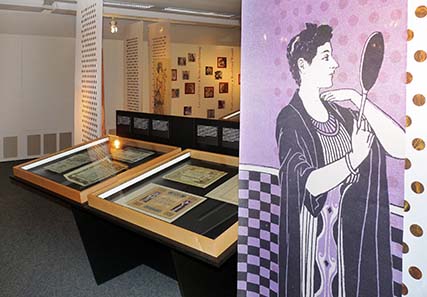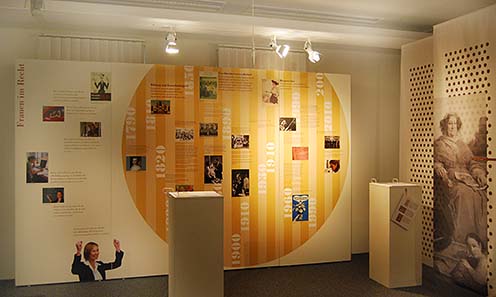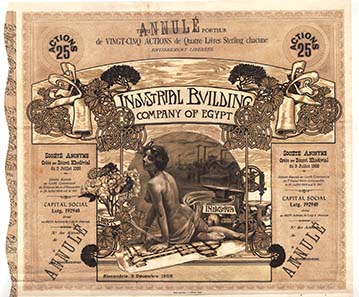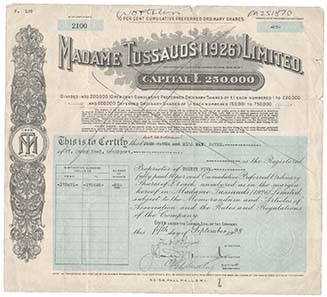September 22, 2011 – It is now 40 years since women were given the vote, 30 years since the Swiss Constitution was amended to guarantee equality between men and women, and 15 years since Switzerland’s Gender Equality Act came into force. In 2011 Wertpapierwelt is marking these anniversaries by dedicating its eighth exhibition to “Women and finance”.
An impression of the exhibition.
While the “world of securities” is still largely perceived as a male-dominated environment, it is not until you take a closer look at historic share and bond certificates that you realize women can be found everywhere you look. In exhibiting around 100 historic securities, the exhibition charts the evolution of women’s portrayal on securities through the centuries and provides a fascinating insight into female investors and businesswomen over time.
There is currently a lot of discussion about how women are perceived not only in the world of finance, but in business as a whole. Women have wealth and they are keen to invest it, but for hundreds of years, their role was limited to that of a marketing icon. It is only recently that they have appeared as investors in the financial markets with a new degree of self-awareness. Nowadays, women not only hold the purse strings in many homes, but are also playing a greater role on the political stage – and this is not just with respect to traditional family issues; women are increasingly involved in shaping financial and economic policy.
Wallcharts inform about the objects in the showcases.
The exhibition is set in a historical context, in the contradictory realm between the exterior perception of women and the selfawareness of female shareholders. As well as the artistic perspective – as shown by the perception of women on securities – certificates which provide a link to the real lives of both prominent and unknown female personalities will also be exhibited.
Opinions
A number of studies carried out in recent years have shown that in this day and age, economic issues and investments are no longer purely a “man’s thing”. Newspapers dedicate pages and pages to reporting on the worldwide distribution of wealth between the sexes, including the differences in male and female attitudes towards investment and the stereotypes associated with this.
The exhibition focuses on women’s role in the modern world of economy.
Social change in the 20th century not only gave women the right to their own wealth, but also brought about the necessity of actively managing it, at the very least as some form of retirement fund. The exhibition also features a number of interviews filmed with male and female representatives from the worlds of science and financial planning, alongside women from a various walks of life, all of whom give their views on the issue.
The portrayal of women on securities
The first section of the exhibition will be dedicated to the images of women on securities from a time when the securities certificate was an important marketing tool for any company. The job of the women pictured on securities was to present dominantly male investors would feel comfortable entrusting her with their money. When the public limited company came into being, it was mainly the classical goddesses that dominated the scene. This more or less abstract representation of assets as personified by women began to change as nation states and the industrial age emerged – goddesses transformed into national symbols.
From the mid-19th century, the way women were portrayed moved quickly towards a more realistic representation. Female farmers and farmhands were first to appear, but exotic beauties also appeared on plantation securities from the colonies. The female factory worker was quick to join them. Whereas this motif is perhaps still based on the idea of the shareholder as an employer, a new and completely different theme emerged at the end of the 19th century – women as consumers. Women from the right circles were giving into to the temptations of consumer society and multiplying the wealth of the shareholders in doing so.
This art nouveau certificate issued by a building company hopes that “sex sells”.
After the turn of the century and the end of Victorian prudishness, the portrayal of women became more and more erotic. The art nouveau period saw topless beauties advertising all kinds of companies: banks, printing houses, electricity providers or construction companies. The slogan “sex sells” applied when it came to marketing many items, including securities certificates, until well into the 20th century. The target group of companies issuing such certificates was still predominantly male.
Female entrepreneurs and investors
The second section of the exhibition features prominent women from real life on companies’ certificates, which were no longer intended to appeal to only male investors. This section also highlights the history of early female investors and businesswomen through to today’s female management staff, who have all left their mark on securities.
The first signs of female nobility investing in securities could be seen as early as the beginning of the 18th century. They had assets to invest and were not subject to the same legal and social constraints as other women in the middle and working classes. This part of the exhibition also casts light on the legal situation of women, who often only had very limited rights of ownership. It is all the more astonishing that a great many shares were registered in women’s names as early as the 19th century.
Madame Tussaud was an independent entrepreneur as far back as the 18th century.
Even though many of the early female shareholders remained anonymous, these certificates prove that females have in fact been investing since almost time immemorial. Entrepreneurs such as Madame Tussaud, who built her own company up at the end of 18th century, or Barbe-Nicole Clicquot-Ponsardin, better known as “Veuve Clicquot”, were the exceptions of their time.
Even today, women in top management positions are somewhat of a rarity. Nevertheless, there are many examples of ambitious women, past and present, who have succeeded in building up their company and making it onto the boards of some of the world’s largest companies.
Symbols of power
Visitors will not only be impressed by the aesthetic quality of these important prints but will also be able to chart the development of the companies (and thus the position of women) over the course of recent centuries. As is the case for all Wertpapierwelt exhibitions, the original securities are presented so that visitors can admire the iconography and fine detail of the certificates. In addition to the main theme of the exhibition, there is also information on the symbolism that appears on historic securities.
All pictures: © Stiftung Sammlung historischer Wertpapiere / Gina Moser Ausstellungsdesign.
For further information on opening hours, how to get there or the very nice exhibition catalog, please click here.




